Step By Step Fairy Easy Passap Tuck Hat

Is one of your New Year’s resolutions to actually use your Passap knitting machine?
Here is a very simple beginner hat in both newborn and adult sizes. It can be knit on any Passap double bed machine. Since this is a very beginner pattern, I’ll take you step by step through a racking cast on, pattern set up, and crown decreases. I realize this will be overkill for many, but I needed lots of pictures when starting out.
Make the newborn size first for practice since it is no larger than a swatch. It’s cute and will force you to practice all the skills required to knit the adult version. When you are ready to experiment with different tuck patterns, you can use this pattern as a base.
Step 1 – Yarn and Tension
I used two strands of 2/24 fuzzy acrylic at tension 4. On the next hat, I’ll probably go up to tension 4.5 or 5 so the fabric won’t be as stiff. Any equivalent yarn will work. If your yarn is thicker and needs a higher tension, your hat will simply be a bit bigger. Remember, the first hat is for practice so don’t get overly concerned about having the same yarn size as my sample. For my yarn, a mast tension of 3 to 3.5 worked well.
Step 2 – Racking Cast On
 For the newborn hat, bring up 44 needles on the front bed, and 44 needles on the back bed.
For the newborn hat, bring up 44 needles on the front bed, and 44 needles on the back bed.
Remember to follow the needle rule – the left most needle is on the front bed and the right most needle is on the back bed. We will be doing a racking cast on for its elasticity. You want the hat brim to stretch.
 Lock at right
Lock at right
N/N
Yarn in eyelet
Tension 4.25 on both beds
Orange strippers
Row counter (RC) 000
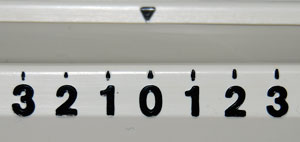 Make sure machine is racked to center before starting. Turn the handle if necessary to get to the “0” position.
Make sure machine is racked to center before starting. Turn the handle if necessary to get to the “0” position.
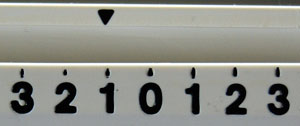 Now rack front bed to the left (counter clockwise) one full turn. When done, handle will be down.
Now rack front bed to the left (counter clockwise) one full turn. When done, handle will be down.
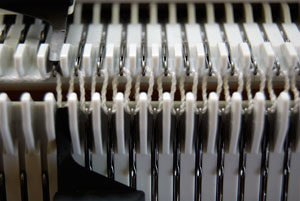 Knit 1 row to the left. The yarn will be loose in the needles.
Knit 1 row to the left. The yarn will be loose in the needles.
 Rack the front bed back to the right (clockwise) one full turn. You will be back at the 0 position and the handle will be down.
Rack the front bed back to the right (clockwise) one full turn. You will be back at the 0 position and the handle will be down.
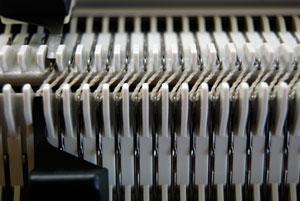 The first row of yarn will now be slanted in appearance, taking up all the previous slack.
The first row of yarn will now be slanted in appearance, taking up all the previous slack.
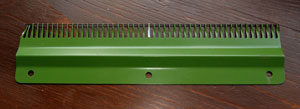 At this point I usually choose to hang the cast on comb. I have far fewer problems knitting tuck patterns with it on. This step is optional.
At this point I usually choose to hang the cast on comb. I have far fewer problems knitting tuck patterns with it on. This step is optional.
If your yarn tension is good, the orange strippers should be enough.
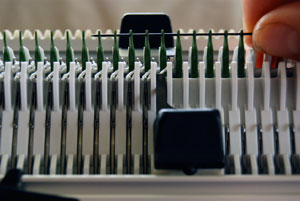 To hang a comb, remove the wire running between the comb’s teeth. Go under the knitting machine, comb teeth up, and evenly insert the teeth through the zig zag row of cast on stitches.
To hang a comb, remove the wire running between the comb’s teeth. Go under the knitting machine, comb teeth up, and evenly insert the teeth through the zig zag row of cast on stitches.
With comb teeth well clear of the stitches, reinsert wire. The wire will rest the comb on top of the zig zag row.
 Hang a weight from the center hole of the cast on comb. The weight will put even downward pressure across all stitches being knit.
Hang a weight from the center hole of the cast on comb. The weight will put even downward pressure across all stitches being knit.
This extra step is worth it to me because I get better stitch construction and significantly fewer dropped loops when I add some weights. Your mileage may vary.
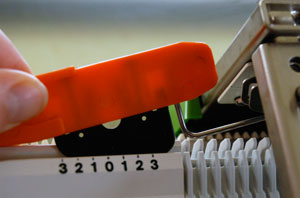 Remove the orange strippers for 2 to 3 lock passes until the metal comb teeth drop down far enough to not rub against the bottom of the strippers. As long as you hang the weight, you won’t screw up your cast on with the strippers temporarily removed.
Remove the orange strippers for 2 to 3 lock passes until the metal comb teeth drop down far enough to not rub against the bottom of the strippers. As long as you hang the weight, you won’t screw up your cast on with the strippers temporarily removed.
If you are not hanging a cast on comb, DO NOT REMOVE THE STRIPPERS.
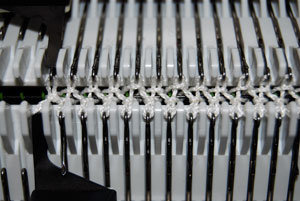 With the cast on comb hung and the lock still at the left, knit 1 row to the right for the second row of the cast on.
With the cast on comb hung and the lock still at the left, knit 1 row to the right for the second row of the cast on.
Your racking cast on is complete.
Row Counter 002
Step 3 – Pattern Set Up
 Bring up one needle on the left end of the back bed, breaking the Passap needle rule. This will insure that the left most tuck loops on the front bed won’t jump off their needle.
Bring up one needle on the left end of the back bed, breaking the Passap needle rule. This will insure that the left most tuck loops on the front bed won’t jump off their needle.
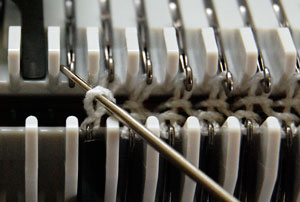 Using a transfer tool, locate the purl bump on the left most front bed stitch and transfer it to the back bed. You will now have 45 stitches on the back bed and the same 44 original stitches on the front bed.
Using a transfer tool, locate the purl bump on the left most front bed stitch and transfer it to the back bed. You will now have 45 stitches on the back bed and the same 44 original stitches on the front bed.
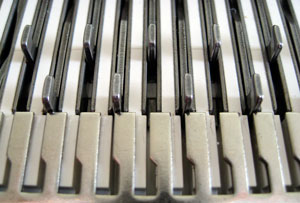 Starting at the left, bring a pusher out of the pusher rail for every needle in work on the front bed.
Starting at the left, bring a pusher out of the pusher rail for every needle in work on the front bed.
Unless there is a needle in work, do not bring a pusher out of the rail. It could accidentally knit and force you to rip out a row. Leave all pushers locked in their rail on the back bed.
 Arrange per the diagram, alternating one up and one down across the bed.
Arrange per the diagram, alternating one up and one down across the bed.
 Start the pattern.
Start the pattern.
Lock at right
N/N and Row Counter 000
Yarn in eyelet
Tension 4 to 5 on both beds depending on your yarn choice
Orange strippers if no cast on comb hung
Knit 4 rows
*If you hung a cast on comb, put in orange strippers after row 2
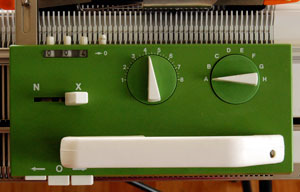 Lock at right. Double check that your stitch dial is set to the “A” position. If not, rotate the dial to the correct letter. When the letter dial is set, move the lever from N to X and push in the left arrow button at the bottom left.
Lock at right. Double check that your stitch dial is set to the “A” position. If not, rotate the dial to the correct letter. When the letter dial is set, move the lever from N to X and push in the left arrow button at the bottom left.
Knit 4 rows
Repeat these 8 rows to row 80
To speed up knitting and lessen the chance for mistakes, leave the left arrow key pushed in during the four N/N rows. The N setting ignores the pushers from a knitting perspective, but the arrow key will still cause the pushers to change positions even when the N/N rows are knit. Since the pattern is done in sets of 4 rows, the pushers will be in the correction position when you switch the lever to knit the four N/AX rows.
Step 4 – How Not To Get Lost In The Pattern
The row counter is your friend. One of the biggest stresses is the fear of getting distracted by life and losing your place in the pattern repeat. Let the stitches and row counter tell you what is happening.
The pattern is an 8 row repeat, half as plain knit, half as tuck. Remember, the row counter trips half way through each row. It always displays what you just knitted.
RC 001-004 N/N <- RC 005-008 N/AX <- RC 009-012 N/N <- RC 013-016 N/AX <- RC 017-020 N/N <- RC 021-024 N/AX <- RC 025-028 N/N <- RC 029-032 N/AX <- RC 033-036 N/N <- RC 037-040 N/AX <- RC 041-044 N/N <- RC 045-048 N/AX <- RC 049-052 N/N <- RC 053-056 N/AX <- RC 057-060 N/N <- RC 061-064 N/AX <- RC 065-068 N/N <- RC 069-072 N/AX <- RC 073-076 N/N <- RC 077-080 N/AX <-
Take some time to look at your stitches between sets of tucking and plain knitting to recognize the differences in their stitch formations. It is much less stressful to “read” your knitting than to try and memorize what each pass of the lock must accomplish. Interruptions will happen. Reading your knitting and double checking the row counter will greatly reduce frustrations.
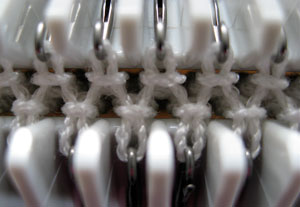 An N/N row looks like this.
An N/N row looks like this.
All stitches on both beds knit with each pass of the lock. You can see the purl bumps on every needle in work.
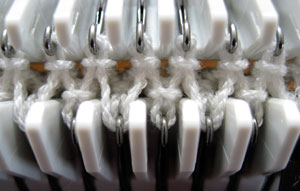 An N/AX row looks like this.
An N/AX row looks like this.
Notice how all the back bed knit stitches have purl bumps while the front bed stitches alternate between needles with knitted stitches to needles with tucked stitches – ie the needle collects up yarn without knitting a stitch. It will knit off on a future pass of the lock, depending on how many tucked stitches the pattern dictates.
Step 5 – Crown Decreases
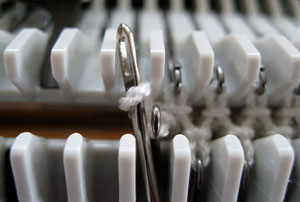 Before starting the crown, decrease the left most stitch on the back bed.
Before starting the crown, decrease the left most stitch on the back bed.
Using a double eye transfer tool, lift the stitch off the needle…
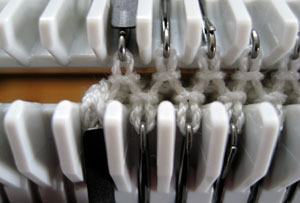 …and move it to the front bed left most stitch.
…and move it to the front bed left most stitch.
There will be two stitches now on this front bed needle. Place back bed needle out of work so it doesn’t accidentally catch the yarn on the next lock pass.
Also, at this time put all the pushers out of work in their rail and clear the arrow key since we are done patterning.
 Row Count 080
Row Count 080
Knit 6 rows N/N
Row Count 086
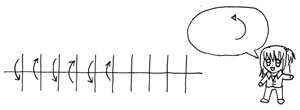 Rack the bed a half turn to the left so needles on both bed are aligned. Decrease stitches per diagram. Starting at the left, transfer the back bed stitch directly across to its corresponding front bed needle, doubling up on the current front bed stitch.
Rack the bed a half turn to the left so needles on both bed are aligned. Decrease stitches per diagram. Starting at the left, transfer the back bed stitch directly across to its corresponding front bed needle, doubling up on the current front bed stitch.
 Continue across, alternating between moving stitches front to back and then back to front.
Continue across, alternating between moving stitches front to back and then back to front.
When done, you will have decreased the crown by half and your stitches will be in a 1 x 1 rib layout. Knit 4 rows N/N. Row Count 090
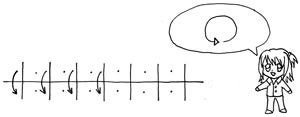 Rack front bed one complete turn to the left, aligning with back bed needles. Transfer all back bed stitches directly across to a front bed needle, doubling up stitches. This decreases the total number of stitches in work by half again.
Rack front bed one complete turn to the left, aligning with back bed needles. Transfer all back bed stitches directly across to a front bed needle, doubling up stitches. This decreases the total number of stitches in work by half again.
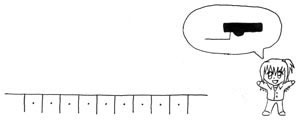 Place all back bed needles and pushers out of work.
Place all back bed needles and pushers out of work.
Change to Black Strippers
Knit 2 rows BX/N
Row Count 092
Hat is finished. Cut yarn from mast leaving a foot long tail. Thread tail through a double eye transfer tool and gather remaining stitches off of machine. After side seam is woven, you will gently pull on this tail, gathering in remaining stitches to form top of hat.
Step 6 – Weave A Reversible, Flat, Almost Invisible Bickford Seam
At this point, most patterns will tell you to mattress stitch the side seam, which involves catching the horizontal threads on each side. That works well for sweaters where a thick seam is hidden on the inside of the garment. This hat is reversible since tuck patterns look great on both sides. When you turn up the brim, you don’t want to see a thick protruding seam.
This technique works when both edge stitches to be woven are plain knit. You need matching sides of knots and loops. I weave up the side by going through the knots and edge loops in a specific order, pulling my weaving thread tight as I go along. The join is basically flat so regardless of which side is chosen, no ugly ridge sticks out. I’ve seen references calling this type of seam a Bickford Seam. I learned how to do it a machine knitting seminar several years ago with no name attached.
Starting at the bottom, line up the two pieces to be seamed by putting the knot from the knot from the left piece of knitted fabric next to its corresponding knot on the right piece of fabric. Loops will automatically align if knots are aligned.
You will be seaming right knot to left knot, then left loop to right loop. Where you start in the sequence doesn’t really matter, as long as you follow the sequence.
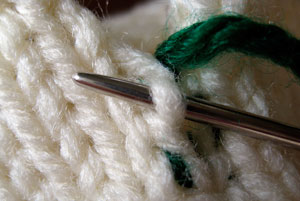 Thread a tapestry needle with yarn. Go up through a left edge knot.
Thread a tapestry needle with yarn. Go up through a left edge knot.
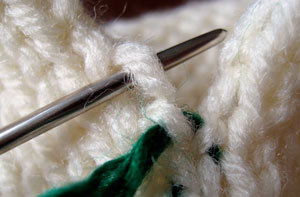 Down through a left edge loop
Down through a left edge loop
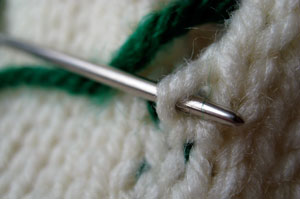 Up through a right edge loop
Up through a right edge loop
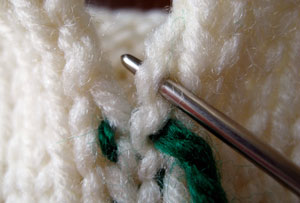 Down through a right edge knot.
Down through a right edge knot.
Repeat these four steps until you reach the end.
This seam can still be seen, but it is the best one I’ve found when you want a truly reversible fabric.
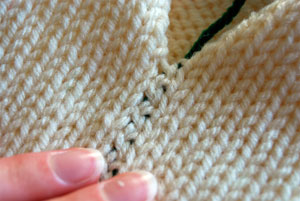 Knit side
Knit side
Even with a dark green yarn for purposes of demonstration, the seaming thread is almost invisible.
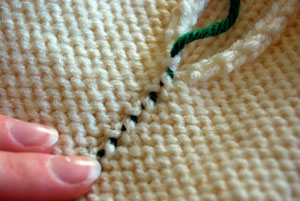 Purl side
Purl side
Step 7 – Gather Top
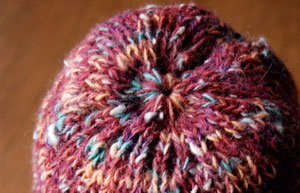 Once the side seam is woven, gently pull on the yarn tail at the top to gather in the hat. I like to thread a tapestry needle and weave this yarn inside the top circle a few times to secure.
Once the side seam is woven, gently pull on the yarn tail at the top to gather in the hat. I like to thread a tapestry needle and weave this yarn inside the top circle a few times to secure.
With your baby hat finished, consider knitting a small blanket using the same tuck pattern. It would make a great layette gift.
Step 8 – Adult Hat
To knit the Adult Hat to fit a head 21 to 22 inches, cast on 90 stitches on both the front and back beds (180 total needles in work) and follow the same steps as for the newborn hat. Knit to pattern row 160 for a very wide brim or row 144 for a narrower brim. Complete the crown as above.
Pictured below is an adult sized hat I knit for my daughter with the very wide brim.
Related Posts
January 5, 2009









19 comments
I really appreciate your careful pattern postings here. I recently bought a Passap from a nearby lady but haven’t yet tackled it, my plan was to spend Jan and Feb learning how to use it. I can see that I will be using your great tutorials to help me learn. Thank you!
Lethe,
I’m glad you find the patterns helpful. Doing all the photos does take a tremendous amount of time, but it makes the directions much clearer for those who haven’t done a racking cast-on, crown decreases, or vertical woven edge.
Thank you Kathryn for your detailed instructions. I just bought a Passap e6000 and while this is for the DM80 it helps me to understand some of the details that experienced knitters might take for granted. I didn’t know when I was supposed to place the cast on comb and how to do it until I saw your instructions.
I’m successfully knitting swatches and changing patterns and colors but I don’t understand how to cast off. Could you explain for me how to do the crochet loop at the edge please? I don’t know how to crochet and the manual assumes that I do.
I read the instructions in the manual and keep trying it but I can’t understand how I’m supposed to catch and drop each loop as I go across.
Thanks again, w/o availability of local instruction at machine knitting stores I’m relying on the internet and the stash of Machine Knitters News the former owner gave me.
I am looking for instructions on how to change a needle for a Passap Dm80 – any help out there? I can’y seem to find anything on the internet.
I’ve had my PassapE6000 for some years but due to life have not managed to learn how to use it. I have just cleared my room out and can now get at my machine. I’m so glad I found your method of sewing the hat. It is similar to a method I developed myself but yours will really seal the seam. Thanks for your page I look forward to knitting the hat and I’ll let you know how I get on.
Sue
the pattern is great as a learning tool. i just purchased a dm 80. i also have to clean a room to put the machine in. i just had surgery for the 2nd time in a week so will no be lifting anything heavy for a few weeks. once i am relased i will start on the room. organization is what i need. i am anixous to get started.
I was once a participant in a very active PASSAP club in Pittsburgh, PA. We were all devestated when the machines were no longer being made. I have an E6000 with motor, and my mom also has the same set-up. Our club disintegrated, and I haven’t touched my machine for years. Lately, I am gettting the itch to start again. Anybody know where there is a service shop on the east coast for cleaning and rehab? I got the more advanced motor, but I think it wasn’t installed correctly, and it never worked for me. I appreciate any help or info! Thanks!
Why don’t you try the Machine Knitters Guild of PA? I don’t know how active they are. Their web site looks a bit out of date but that doesn’t mean they aren’t knitting.
http://www.geocities.com/debsaknittin/MKGOP
I need to find out who can sell me parts for my Passap DM-8O
Thank you so much for the great detailed instructions. I have just finished the baby hat and plan to make the adult version. I received the passap 80 from my daughter who brought it from Switzerland at Christmas.
I would love to find more patterns someplace,
thank you very much for the illustration but can it be done on Brother knitting machine
I need to learn how to cast off on a Passap dm80
Thank you very much for the great instructions and photos. I have finished two hats and had fun making them!
Also thank you so very much for your instructions on deep cleaning a Passap. Without them my Pinkie would not be working!
please someone can help me, l bought a passap duomatic S green colour and need to clean it and to set the adjustments and l do not have instruction to do it. l will be very please if some one can help me; l have yarn to knitt by hand in 4. and 4.5 and do not know where to get the scale of tension to apply
thank you for your hel^p
gigi
I just got my new/used Passap DM80. Years ago I had one and gave it away
when we moved south.
I picked my new/used KM this am and have no books or patterns, therefore, your
descriptions and pictures are a wonderful help to start over.
Thank-you
Awesome pattern! My first hat after finishing the duomatic 80 manual. Your instructions for casting on using racking was better than the manual. 🙂
But……I still cannot figure out how to hang a weight (cast on comb) on my passap pinky. I don’t think I have a ‘wire’ under any needles. Mystified…….
Carmeen
Very very much appreciated. Just unearthed my old second hand passap E6000 and determined to master it this time. Just what I need a step by step pattern with pictures. Brillian.
Thank you once again.
Sue
Thank you for writing this tutorial. This is my first completed project since owning a “loaded” Duo 80 off craigslist from last year. I have been overwhelmed trying to understand how to use it and make something. I finally dug out my sock yarn and made a hat with your pattern. I had trouble with jamming the next time I used it on Row 2, but we think it had to do with the thread holder not seated right in the holder. I was able to make another one yesterday and feeling more confident each time I get something to work. I am dreading to have the clean the machine, but I think it may need it. I have no history on the machine, except it was used for a private business. Came with motor, form computer, loads of magazines, 4 color changer…thanks again!!!